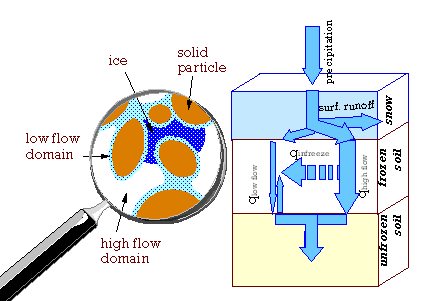Hydraulic conductivity
When ice is formed in the soil the flow paths of water are altered. Under partially frozen conditions the soil can be considered to consist of two flow domains, one consisting of small pores where water is unfrozen due to a low water potential, and another consisting of large pores that are air-filled because of surface tension effects (see Figure 1.4). In the former one consisting of small sized pores the flow will consequently be much slower than in the high-flow domain, and this domain is thus called the low-flow domain. The other flow domain, the high-flow domain, consists mainly of large air-filled pores that allows for a rapid water flow.
The water content of the low-flow domain is determined by the soil temperature (below 0 oC) and the freezing point depression curve (c.f. sensible and latent heat content of a partially frozen soil), whereas the water content in the high-flow domain depends on the amount of infiltrating water, the hydraulic conductivity of that domain, khf, and the water refreezing rate, qinfreeze, (see below).
The flow in the low-flow domain is driven by the water-potential gradient according to Darcy’s law (eq. 2.1) as for unfrozen conditions.
The calculation of the water flow in the high flow domain is optional (see switch FlowDomains). Water flow in the high-flow domain is unit gravitational flow based i.e., corresponding to the hydraulic conductivity of that domain, khf:
where kw(θtot) is the hydraulic conductivity corresponding to all volume occupied by water and kw(θlf+θi) is the hydraulic conductivity corresponding to the volume occupied by water in the low-flow domain and ice. The reduction term, θi/cθ, i, where cθ, i is the damping ice content, accounts for the blocking effect of ice. See viewing function High-Flow Domain Damping Function.
Figure 1.1 The flow paths and the hydraulic conductivities for the two domain approach. (After Stähli et al, 1999)

